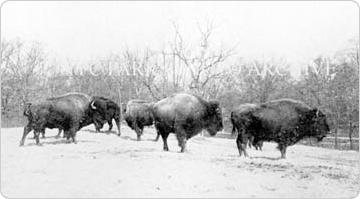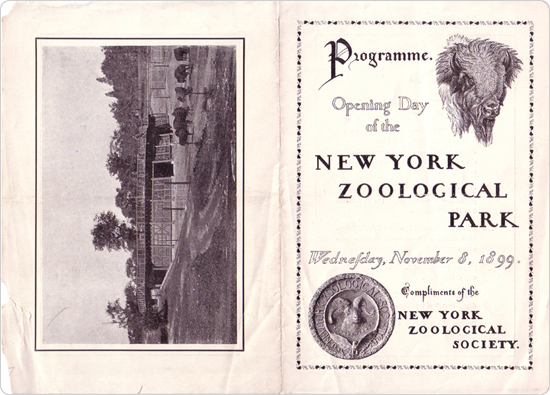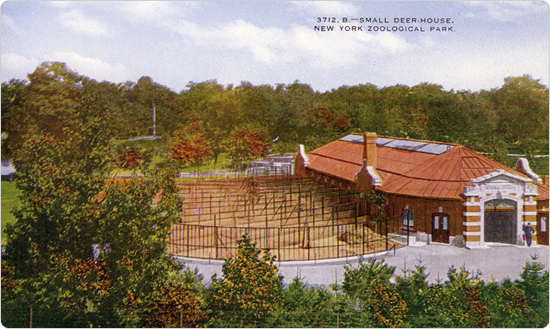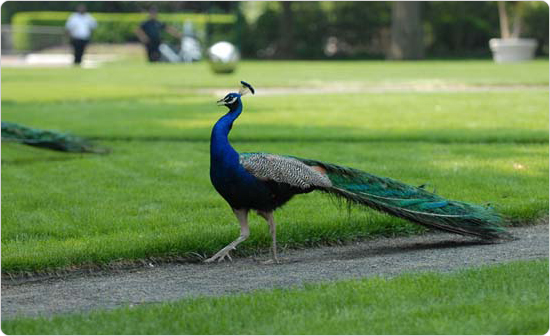Visit the Bronx Zoo website for information on the zoo today and its exhibits.
History of the Bronx Zoo
The Bronx Zoo is one of the most famous zoos in the world. In 1898, the City of New York allotted 250 acres of Bronx Park to the New York Zoological Society to build a park aimed at preserving native animals and promoting zoology. The Bronx Zoo opened in 1899 and remains one of the largest wildlife conservation parks in the United States, housing 4,000 animals representing more than 650 species.
Several architectural features at the zoo are official city landmarks, including the entire area from the Rainey Gate entrance on Fordham Road (itself landmarked in 1967) to the far end of Astor Court at Zoo Center (landmarked in 2000). The buildings in Astor Court were designed by the firm of Heins & Lafarge, who also designed the original plans for the cathedral of St. John the Divine in Manhattan's Morningside Heights and many of the subway station details on the IRT line. Another landmarked feature, the Rockefeller Fountain, was built by Italian sculptor Biagio Catella in 1872, donated to the Zoological Society by William Rockefeller in 1903, and moved to its present spot in 1910 (in 2008 the fountain was restored). Another historic landmark is a souvenir from the Ice Age known as the Rocking Stone overlooking the Buffalo Range. The stone is a rough cube of pinkish granite, resting on a granite slab base; even though it is roughly seven feet high and 30 tons, it is balanced perfectly and cannot be moved.
A great deal of the ongoing work at the zoo is unseen to visitors. The Wildlife Society supports conservation efforts as far away as Africa and sends its animals around the country to breed. In fact, the Society has been at the forefront of conservation and field research since its earliest days, beginning with a successful effort to save the American bison from extinction in 1907. The Society helped advocate for the Arctic National Wildlife Refuge in Alaska, which opened in 1960, and assisted and worked to establish wildlife preserves in countries such as Tanzania, Kenya, China, and Argentina.
The zoo made strides to pull animals out of cages early on, especially with the groundbreaking African Plains habitat, the first exhibit of which opened in 1940 when “Lion Island” debuted. The zoo's Skyfari aerial tram opened in 1973, and in 1977 the Wild Asia exhibit opened on 38 acres of previously undeveloped land. Its specially designed monorail takes visitors through an Asian wild animal habitat, and at its opening featured elephants, lions, tigers, rhinoceroses, and deer. In 1999, the $43 million Congo Gorilla Forest opened, featuring several different climates and a viewing tunnel for visitors. The zoo's $8.5 million Tiger Mountain exhibit opened in 2003, allowing visitors an eye-level (actually eye-to-eye level: the Siberian tigers are behind two-inch-thick glass) view where once the animals could be seen only via a Monorail ride. The habitat features heated rocks and cooled water, allowing the tigers a climate-controlled environment. The exhibit is an outgrowth of a partnership between American and Russian biologists, one of the fruits of the zoo's research missions. Madagascar!, which opened in 2008, highlights the unique habitat of the African island, including four types of lemurs, crocodiles, and hissing cockroaches.
The Bronx Zoo has many monuments presented to the city including Paul Manship's expressive Rainey Memorial Gate, featuring 22 full-sized sculpted animals rising above on a vine-like pattern located at the Fordham Road entrance to the zoo, and the aforementioned Rockefeller Fountain.




